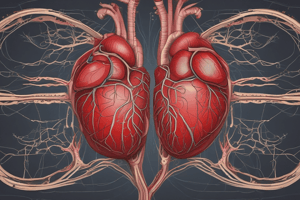Podcast
Questions and Answers
What is the primary function of the cardiovascular system?
What is the primary function of the cardiovascular system?
- To filter out toxins from the blood
- To produce hormones and enzymes
- To regulate body temperature
- To deliver oxygen and nutrients to cells and remove waste products (correct)
Which type of blood vessels carry oxygenated blood away from the heart?
Which type of blood vessels carry oxygenated blood away from the heart?
- Capillaries
- Lymphatic vessels
- Arteries (correct)
- Veins
What is the term for the pressure in the arteries when the heart beats?
What is the term for the pressure in the arteries when the heart beats?
- Hypertension
- Blood pressure
- Systolic pressure (correct)
- Diastolic pressure
What is the function of baroreceptors in the regulation of blood flow?
What is the function of baroreceptors in the regulation of blood flow?
Which system regulates heart rate and blood vessel diameter?
Which system regulates heart rate and blood vessel diameter?
What is the term for the circulation of blood from the heart to the lungs to pick up oxygen?
What is the term for the circulation of blood from the heart to the lungs to pick up oxygen?
Flashcards are hidden until you start studying
Study Notes
Definition and Function
- The cardiovascular system, also known as the circulatory system, is a network of organs and vessels that transport blood throughout the body.
- Its primary function is to deliver oxygen and nutrients to cells and remove waste products.
Components
- Heart: a muscular organ that pumps blood throughout the body
- Arteries: blood vessels that carry oxygenated blood away from the heart
- Veins: blood vessels that carry deoxygenated blood back to the heart
- Capillaries: tiny blood vessels where oxygen and nutrients are exchanged with cells
- Blood: a liquid tissue that transports oxygen, nutrients, and waste products
Blood Flow
- Pulmonary circulation: blood flows from the heart to the lungs to pick up oxygen
- Systemic circulation: blood flows from the heart to the rest of the body to deliver oxygen and nutrients
Blood Pressure
- Systolic pressure: the pressure in the arteries when the heart beats
- Diastolic pressure: the pressure in the arteries between beats
- Hypertension: high blood pressure, a major risk factor for cardiovascular disease
Blood Vessels
- Elastic arteries: arteries that stretch to accommodate blood pressure
- Muscular arteries: arteries that constrict or dilate to regulate blood pressure
- Veins: have one-way valves to prevent backflow of blood
Regulation of Blood Flow
- Autonomic nervous system: regulates heart rate and blood vessel diameter
- Baroreceptors: sensors that detect changes in blood pressure
- Chemoreceptors: sensors that detect changes in oxygen and carbon dioxide levels
Studying That Suits You
Use AI to generate personalized quizzes and flashcards to suit your learning preferences.





